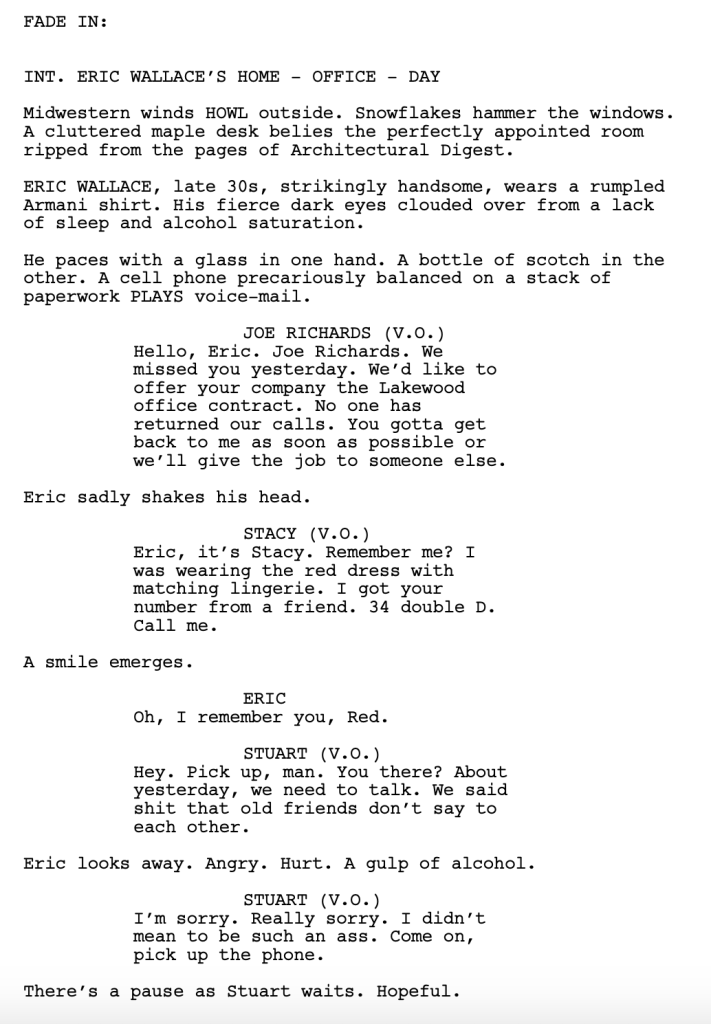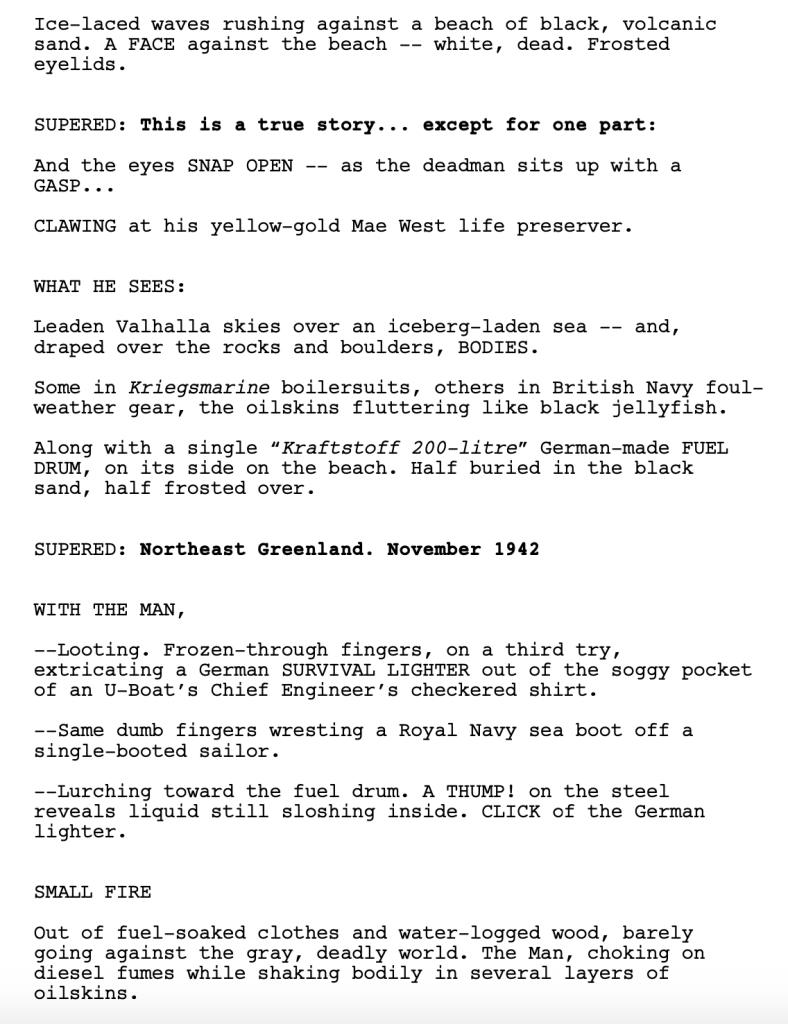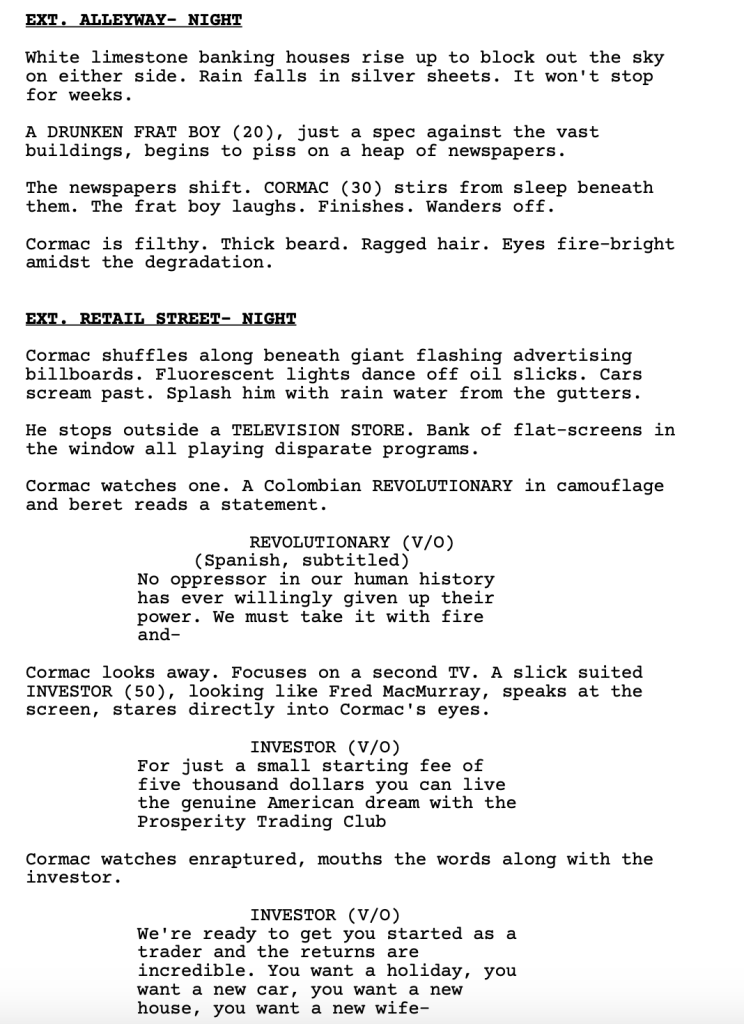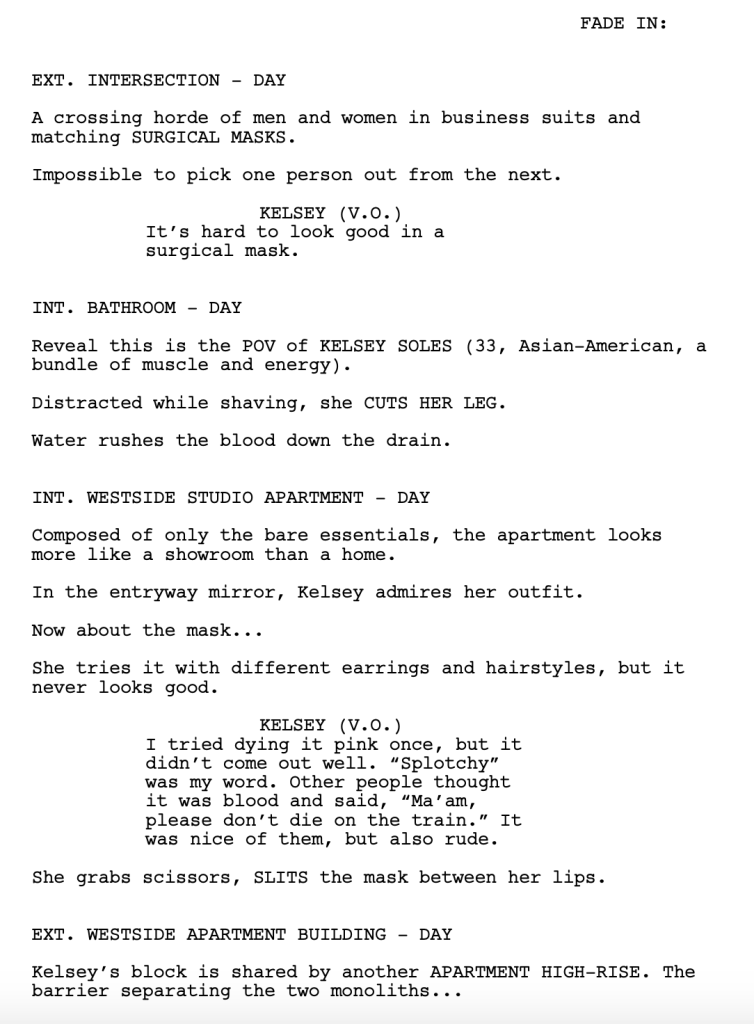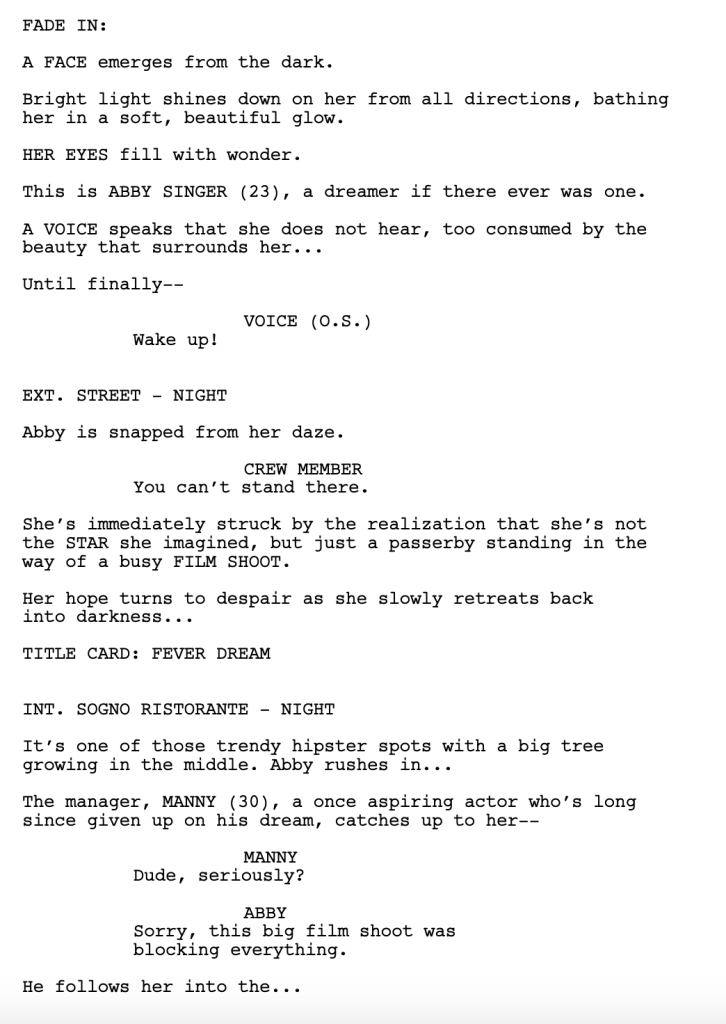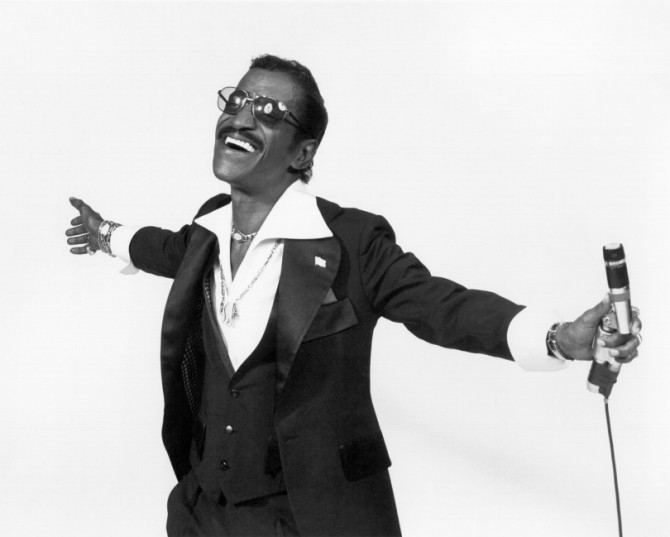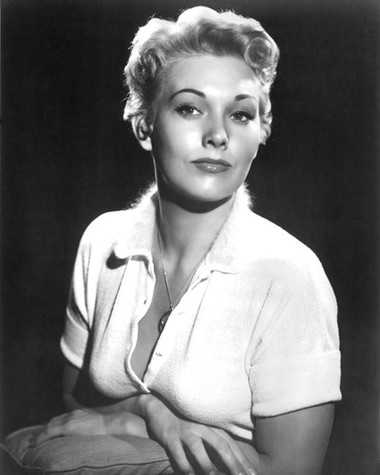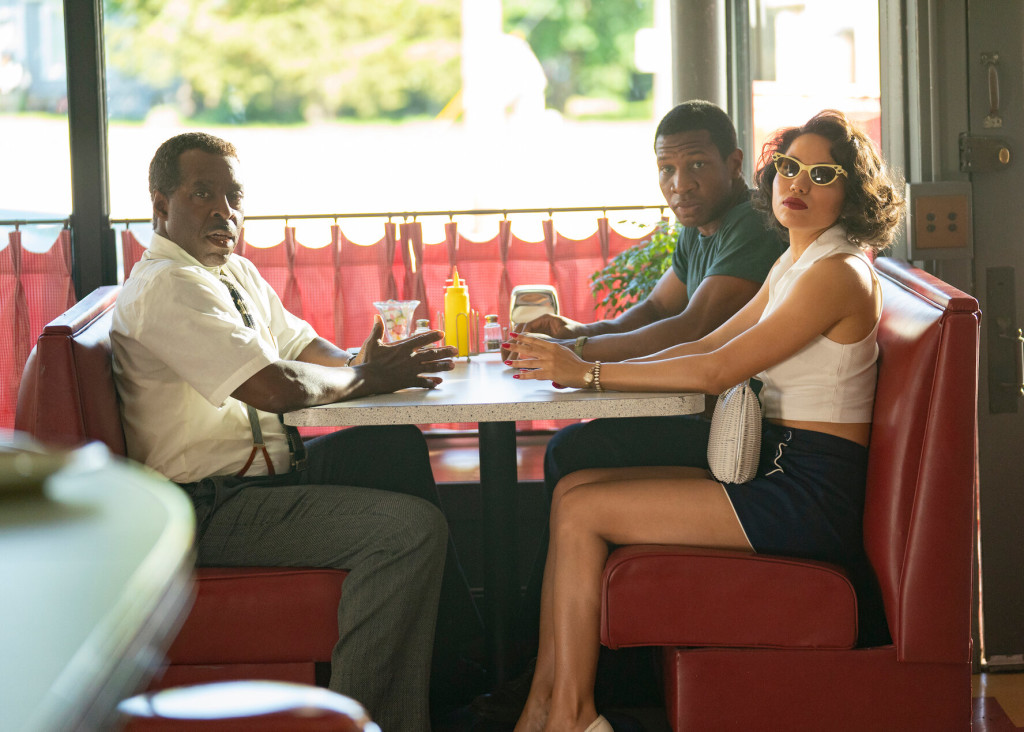Your nights have been lonely. Your days? A pastiche of whimsical memories fading into each other like snowflakes drifting down to their sad thawed demise. Am I talking about your life since Covid? Nope. I’m talking about your life since Amateur Showdown.
But that changes today because AMATEUR SHOWDOWN IS BACK!
Like an old friend you’ve lost touch with who calls and screams, “I’m in town for one weekend. Let’s get wild!” That’s what Amateur Showdown has done. “Oh, don’t you worry. We’re going to get wild, Amateur Showdown. We’re going to get wild in ways that aren’t allowed on television!” That’s because this Amateur Showdown is the craziest of them all.
Character Piece Showdown.
Uh-huh. You read that right. How much more juicy does it get than introspective character exploration? Not even The Daily Mail will touch this it’s so risque.
I’ve been on the phone all week talking with frustrated advertisers. “Carson,” the CEO of Coca-Cola, Jerod Moss, said to me. “How can I post ads on your site when you’re talking about character flaws, inner conflict, the Hero’s Journey for God’s sake, Carson. The Hero’s Journey! How do I spin that to board members!?”
Believe me, it hasn’t been easy. I nearly canceled. I can’t have this kind of controversy following me around. But unlike Rick, I do stick my neck out. And despite the rabid protests outside my place demanding I not mention “character” and “piece” in the same sentence or I will face consequences, I’m moving forward. And I hope that you move forward with me. Cause I can’t do this alone.
That reminds me. The next Amateur Showdown will be October 16th and it will be a HORROR SHOWDOWN. Yes. We’re going to drape ourselves in the color of blood and indulge our inner freak show, all in time for Halloween. And don’t forget, you can enter SHORT HORROR STORIES as well as Horror scripts. So, if you’re going to enter, send me a title, logline, genre, why we should read your script/story, and a PDF of the story/screenplay to carsonreeves3@gmail.com any time before Thursday, October 15th, 8pm Pacific Time.
Now on to today’s scripts. If you haven’t played Amateur Showdown before, this is how it’s done. I pick five screenplays that were submitted to me and then you, the readers of the site, read as much of each script as possible and vote for your favorite in the comments. The winner will receive a review the following Friday that could result in props from your peers, representation, a spot on one of the big end-of-the-year screenwriting lists, and in rare cases, a SALE!
One last thing. This was one of the harder Showdowns to choose contestants for. A lot of you took the term “character piece” very liberally. The generes for these scripts were all over the map. I had to make some tough decisions on if picks were right for the showdown, but if you didn’t get picked, it was probably because I didn’t consider your entry “character piece” enough.
Anyway, good luck to all!
Title: The Wallace Web
Genre: Drama
Logline: When Eric’s business partner confesses that Eric’s dad has been paying him to ruin their company, Eric enlists the help of his estranged brother to confront their overbearing father.
Why you should read: When I was 18, my first job was the receptionist at a property management company. One of my many responsibilities was to accept contractor bids, log them in, and make sure they went into the correct job basket. One day a contractor handed me his bid proposal and asked that I pull his son’s bid for the same construction job. I politely told him no. He came back the next day with flowers, trying to bribe me to take his son out of the running! Who does that? I lied and told him the bids were already collected. His nice demeanor turned angry in an instant. I always wondered what the story was behind that family. Family and business are always good drama. I’ve had feedback from readers including “best dialogue ever” and another one called it the next “Warrior”. Thanks for reading my submission. I’m grateful for all the comments and suggestions.
Title: Dog Sled Patrol
Genre: Thriller, Period drama
Logline: In 1942, the sole survivor of an u-boat-destroyed British arctic convoy is paired with a native Inuit hunter on a months-long journey across the frozen wasteland of Northern Greenland. Before reaching civilization, they must survive the unforgiving conditions, an outside threat lurking in the dark — and the fact that one of them is not the person he says he is.
Why you should read: It’s World War 2, and you and your partner are on a patrol in one of the coldest, remotest, most desolate parts of the world — months of travel from the nearest outpost, in the deadly cold of a polar night, with only your 13 dogs for company.
To survive on the ice riddled with deadly traps of open-water “leads”, with white-coated terrors stalking just out of the view of your fading headlamp and the constant threat of a submarine Nazi incursion looming behind the icebergs, every “day” of the endless night you put your life in your partner’s hands — and him in yours. You get to know the other man closer than your own brother or a lover. One night, in your tent… he starts speaking German in his sleep.
Title: Few Die Well
Genre: Thriller
Logline: After a homeless veteran murders a banker in self-defence, he impersonates the dead man in an effort to land his dream job and lift himself out of poverty.
Why you should read: I’ve always been fascinated by stories of conmen and imposters, individuals for whom every word is fraught with the risk of discovery. Few Die Well charts the consequences of one penniless outsider’s attempts to claw his way up to the top through an elaborate lie of his own. He enters a world of staggering wealth and savage violence as he finds himself drawn into the orbit of scheming grifters, crooked cops and ambitious politicians. Its inspirations are myriad, the film noirs of the 1940s and 50s, the gritty crime dramas of the 1970s and the recent spate of intelligent thrillers like Nightcrawler and Parasite. In writing this screenplay, I set out to craft a character piece that has GSU at its core, that moved at a rapid pace without sacrificing development and depth. It comes in at a slim 87 pages and it ends with a bang.
Title: Love Sick
Genre: Character Piece / Romance
Logline: A door-to-door saleswoman struggles to keep her new relationship with a young journalist alive when she is forced to medically quarantine.
Why you should read: You may have noticed there was a quarantine going on for a while a few months ago. That’s to say that this script is insanely topical. Probably almost too much so. But maybe, just maybe… it’s also exactly the type of script that needs to be read right now: An introspective look at what it means to be human when the world goes to shit around you.
Title: Fever Dream
Genre: Psychological Thriller
Logline: After being assaulted, a struggling actress with a traumatic past gives a riveting audition, landing the lead role in a film. But the more she delves into the dark mind of the character, the more her dream becomes a nightmare.
Why you should read: Let’s face it, you gotta be pretty crazy to try and have a career in this industry. Most of us spend all our time working for free just in the hopes of one day getting a job that actually pays us. Well, after writing and directing my first feature (which landed a distributor, had a theatrical release, and even sold to Showtime), I actually thought I was on my way. And then… crickets. As far as the industry was concerned, no one f-ing cared. It was back to staring at the blank page all over again, hoping this time things would somehow be different. That’s when I realized how crazy this whole thing is, and when the idea for my new film was born.
Fever Dream is a timely, taut thriller that grabs you by the throat and never lets go. It’s a wild cross between Black Swan and Mulholland Drive that forces you to question how far you’re willing to go to achieve your dream, and at what price, and has an ending that will leave you breathless and wanting to go back and experience it all over again. Thanks for giving it a shot!
Conquer exposition once and for all!!!
It’s been a while since we’ve talked about exposition. The reason for that is, most writers who’ve broken into the professional ranks don’t have exposition issues. They might be struggling with other aspects of storytelling. But exposition is, for the most part, a beginner and intermediate problem. Therefore, I’m not running into tons of exposition issues in the pro scripts I review.
But when I’m reading the Last Great Screenplay Contest entries, I’m seeing exposition problems all over the place.
Why is exposition a problem? Well, the number one reason exposition is problematic is that it’s a dialogue killer. You can’t focus on the more advanced things that make dialogue work if you haven’t mastered exposition.
So what is exposition? Exposition is any information about your characters or plot that you’re trying to fit into your dialogue. So, for example, if it’s important that the reader know your character was a former karate champion (because, later in the movie, he uses karate to beat someone up), exposition would be two characters mentioning, early on in the screenplay, that this character used to be a former karate champion.
The super beginner screenwriter might formulate the conversation like this…
DOUG: Hey, how’s the karate coming along?
FRANK: Oh, I haven’t done that in years.
DOUG: But you used to be a champion, right?
FRANK: That was a long time ago.
Extremely on the nose, right? A more experienced beginner might tackle it this way…
DOUG: Guess who I ran into today? Bill Lane. He mentioned that old karate tournament you used to compete in. We were trying to remember where it was.
FRANK: Encino.
DOUG: Right. Encino. Anyway, he was telling me he just got divorced…
A teensy bit better. But still bad.
What I’m going to do today is cover two strategies you should always consider before using exposition. Then I’ll go into the two main approaches I endorse for writing exposition.
Let’s start with the strategies. The first strategy you should consider when facing exposition is not including it at all. Most of the time we THINK we need exposition when we don’t. Let’s say you’re writing a Fast and the Furious type script and you feel like you need to establish that your hero, MIKE, has an extensive history with a character who will be appearing in the story later, DERONIS. Maybe they sold drugs together, raced cars together, STOLE cars together. Whatever.
So you include a scene early on where Mike is talking to his wife and says, “I’m going to have to see Deronis this weekend.” We can tell his wife isn’t happy about this. “When was the last time you talked to him?” “Barbados. ’04. When he was running Kamikaze’s business.” “When he ratted you out.” “Yeah.”
This isn’t the worst dialogue but you have to ask yourself, do you really need it? Consider the alternative. Don’t mention any history between the two of them and then, when they meet, Deronis says, “Hey Mike.” “Hey.” “Haven’t seen you since Barbados.” Mike offers a tight smile. And that’s it. Or, you don’t even need the Barbados part. “Haven’t seen you in a while,” followed by a tight smile. That gives us all the information we need. These guys have a history and it isn’t all good. This should always be your first weapon against exposition. Cause the best exposition is no exposition.
Strategy number 2 is show us rather than tell us. If you have to use exposition, come up with a visual way to do so. And no, that does not mean cut to a karate champion trophy to convey that the character is a karate champion. Or, one of my favorites, the “series of pictures” to show what’s gone on in the family. The first picture is a happy family of four. In the second picture, placed next to it, the mother is bald and pale. And in the third picture, it’s just three family members, the mom dramatically gone (I can’t tell you how many times I’ve encountered this). Sure, these are viable ways to convey information in a pinch. But that’s not what I’m talking about.
I’m talking about if you’re writing Star Wars and you want to convey that Darth Vader is the most feared man in the galaxy, you don’t have two characters discussing all of the awful things that Darth Vader has done in the past. You simply show Vader demanding information from a Rebel soldier and when the soldier doesn’t reply, Darth Vader lift him up off the ground and crack his neck. Showing us that is better than anything you can tell us about Vader.
But let’s say there’s information you really feel that the reader needs to know. And there isn’t any natural way you can provide the information by showing. In that case, you want to use the “Spotlight and Shadow” approach. The big mistake newbie writers make when writing exposition is that the exposition becomes the reason to write the scene. As a result, the scene feels utterly unnatural. The reader senses that the only reason the characters are talking is to give information to them. In this case, you are spotlighting the exposition.
What you want to do instead is play exposition out IN THE SHADOWS. The thing you should be spotlighting is the ENTERTAINMENT. A character wants something in the conversation. That something has stakes attached to it so it feels important. There’s conflict. There’s drama. And for those reasons, the scene is fun to read. What the reader doesn’t realize, however, because you’ve put the spotlight on the entertainment, is that IN THE SHADOWS you’re disseminating exposition.
The example I always love to use is the scene in Ferris Bueller when he calls his sick friend, Cameron, and tries to convince him to ditch school with him. The spotlight is 100% on the entertainment. Ferris has a clear goal. Convince his friend to ditch school. His friend doesn’t want to, which creates conflict. And so all we’re focused on is whether Ferris is going to convince his friend or not. Meanwhile, we get exchanges like this: “If you’re not over here in 15 minutes, you can find a new best friend.” “Ehh! You’ve been saying that since the fifth grade.”
That line is exposition. It just told the audience that these two have been best friends at least since the fifth grade. But even the keenest moviegoer probably wouldn’t have identified that moment as exposition. It’s just a natural extension of the conversation they’re having. AND THAT’S THE POWER of the spotlight and shadow approach. The spotlight is so far over here on whether Ferris is going to achieve his goal or not that all exposition is happening in the shadows.
The beginner writer would’ve made Ferris and Cameron’s backstory the spotlight of the scene. Ferris might’ve called Cameron just to see what he was doing. And now, the beginning screenwriter thinks, I can get them talking about their past. So Badly Written Ferris says something like, “Do you remember when we first met?” Badly Written Cameron replies, “Of course. Fifth grade English class.” “Missus Baxter.” “Oh, she was the worst!” “She smelled like fungus. And what did I say to you after you failed that test?”
Is that the worst dialogue? I don’t know. I guess it’s not bad. But what is bad is that all we’re focusing on here is learning things about the characters that the writer wants us to know. That’s what you’re doing wrong. The spotlight is on the wrong thing. You need to spotlight an entertaining scene and then hide your exposition in the shadows of their conversation.
Okay, but what happens when you need to convey SO MUCH EXPOSITION that there’s no shadow big enough to hide all of it? You usually run into this problem in heavily plotted movies where you need to tell the audience a bunch of information about the plot so that they understand what’s going on.
An obvious example would be a heist movie where the group has to explain to the audience things like what time the bank closes, what the group has to do once they’re inside the bank, what each individual person’s job is. If you don’t tell us these things and just jump to this heist, we’ll likely be confused about what’s going on. You see these scenes all the time in the Mission Impossible movies.
If you’re in this situation, I want you to use a device similar to the spotlight and shadow approach. I call it the ‘balancing scale.’ You know what a balancing scale looks like. It’s got two plates, one on each side. We’re going to call the left side the ‘entertainment’ side and the right side the ‘exposition’ side. Whenever you’re writing one of these scenes, make sure that the entertainment side is always more weighed down than the exposition side.
Where writers make the mistake is that they pile too much exposition onto the right side of the scale. Writers will use the term, “exposition dump.’ It’s a term I detest. Never ever write a scene whose only purpose is to dump exposition. EVER! You can always make a scene entertaining. Even ones with lots of exposition. And the more the left side of the scale (the entertainment side) can outweigh the right side, the less people are going to realize the exposition.
Unfortunately, it’s never clear how to create the entertainment side of these scenes. You have to be creative. One trick I like to use is to see the scene as its own little movie. And how do I tell a story (that has a beginning, middle, and end) within this scene. The scene where Doc teaches Marty about his time machine could’ve easily been an exposition dump scene. A bad writer would’ve had Doc call Marty over to his garage where he very casually showed him the time machine and explained how it worked.
Instead, the writers start the scene off with a mystery component. What is Doc going to show Marty (the beginning of our mini-movie)? Then, instead of Marty being a passive participant, the writers make him active. Doc has him record the demonstration for historic purposes. Then, we do a test run. So there’s an exciting element to whether the test will be successful or not. The focus at every point is on the entertainment.
In the meantime, the writers are slipping exposition into the crevices of the scene. One of the most important pieces of exposition in the movie is how the time traveling works, from the three separate timing displays to the 88 miles per hour. Again, the scene is designed so that Doc is making Marty tape all of this for prosperity’s sake. The reason he’s showing him these displays is not because he wants to. It’s because he has to. The time travel needs to be documented.
That scene has more exposition in it than any scene you will ever write. So if they can do it, you can do it too. It just takes work. Believe me, I know it’s easier to sit two characters down in a chair and have one reel off the 20 time traveling rules to the other. It takes zero thought. But if you want the reader to actually enjoy themselves, you need to do the hard work of entertaining them as opposed to educating them.
Now get back into your screenplays and banish all that exposition!
Good luck!
Carson does feature screenplay consultations, TV Pilot Consultations, and logline consultations. Logline consultations go for $25 a piece or $40 for unlimited tweaking. You get a 1-10 rating, a 200-word evaluation, and a rewrite of the logline. They’re extremely popular so if you haven’t tried one out yet, I encourage you to give it a shot. If you’re interested in any consultation package, e-mail Carsonreeves1@gmail.com with the subject line: CONSULTATION. Don’t start writing a script or sending a script out blind. Let Scriptshadow help you get it in shape first!
Genre: Period/50s
Premise: The controversial relationship between Sammy Davis Jr. and movie star Kim Novak, an interracial celebrity pairing at a time when interracial relationships were outlawed in half of America.
About: This script won the Austin Film Festival screenplay contest. It also finished in the finals of the Nicholl Fellowship (but was not one of the winners). This draft of the script (which was in the contests) was written by Matthew Fantaci but is currently being rewritten by Janet Mock, who wrote on “Pose,” the Ryan Murphy show that chronicles the downtown social and literary scene in 1987 New York.
Writer: Matthew Fantaci
Details: 95 pages
I’ve always seen Sammy Davis Jr. as a curiosity. He was so unique that at times, he appeared cartoonish. Maybe that’s why I was never into him. But there’s no denying that the Rat Pack days were unlike anything we’ve seen before or since in Hollywood. Here in the 21st century, you get more of the Entourage approach. One famous guy and a lot of Turtles.
So I popped this one open with a doubtful click, hoping it would win me over.
It’s 1950s Vegas. Sammy Davis Jr. is one of the most popular entertainers on the planet. Black, Jewish, and Puerto-Rican, he was truly one of a kind. And boy could he light up a room. Ironically, back then, Sammy couldn’t even stay at the hotels he performed at. Black people weren’t allowed rooms.
Meanwhile, Kim Novak had become one of the biggest movie stars in the world. But unlike other stars, Novak was rebellious. You see, back then, everything about your person was crafted by studio heads. Novak was known by the world as “The Lavender Girl.” Yet she hated lavender. And the fact that she openly rejected the label infuriated her handlers.
One day, after a Sammy performance, he bumps into an exhausted Kim, who’s just finished a long photo shoot. Kim doesn’t have the strength to bullshit and falls into a natural friendly conversation with Sammy. It goes so well that the two start hanging out regularly. And then sleeping together. Which normally would be great. Except that in 1950s America, nobody accepted interracial relationships, especially one between a black man and a white woman.
When Columbia studio head and evil bully Harry Cohn gets word of this, he calls Kim in and tells her that if she doesn’t end this before the gossip columnists get hold of it, he’s going to ruin her life. Although I have not wikipedia searched Harry Cohn, the script paints him as some combination of Harvey Weinstein and Hitler. So when he says he’s going to ruin someone’s life, you get the impression he means it.
Despite that, Sammy and Kim decide to take their romance semi-public, appearing at friends’ parties together. There’s only one step left to go and that’s to date in public. The two discuss what this step means and concede that there’s no coming back from it. So if they’re going to do this, they have to make sure they REALLY want to do it.
The pressure eventually overwhelms them, however, and they give in to the threats (even coming from Sammy’s friend Frank Sinatra), splitting up. It’s a decision that will leave both sides wondering “what if” for the rest of their lives.
If you’re going to make a commentary on a hot button social issue, I think this is the way to go. You don’t give us a non-fiction retelling of whatever’s been popping up on our news feeds for the last 83 days. You explore a story that has similar themes and overlap with the hot button issue, but because it’s not the exact same, it forces the reader to think to make the connections. It makes the audience feel like they’ve solved a puzzle, which is more fun than having someone place a Rubik’s Cube in front of your face that’s already completed.
But I can never discuss these scripts without going back to my frustrations with the biopic format. While I like that this isn’t a cradle to grave Sammy Davis Jr. story and that, instead, we’re seeing this specific charged section of his life, I still spent half the read wondering, “What is the point of this? Where are we going? Where’s the goal?”
The only thing pushing the story along is “Will they or won’t they?” And while it’s certainly more charged than the storylines we typically get in “will they or won’t they?” (romantic comedies), I still felt a slow narrative that left me wanting more. I need that character goal. I needed Sammy to be going after something.
Since he’s not going after anything, all his scenes are some variation of waiting for when he’s going to see Kim next.
And don’t get me wrong. It’s possible to make these narratives work. The script is packed with conflict. And it has one of the better villains I’ve read in a while in Harry Cohn. But it’s still anchored down by that dull rickety story engine known as “Will they or won’t they?”
Getting back to Sammy, he’s a real tough guy to take seriously. He was such a character in real life that I found myself struggling to see him as a romantic man trying to engage in a relationship. It’s like trying to imagine Charlie Chaplin in a relationship after watching Modern Times. Or David Blaine confessing his love without eating a live frog and then having it jump out of his ear.
But if you’re into this era, into old Hollywood, into the Rat Pack, you’ll probably love this. It even feels like an old fashioned movie, with the quick witty dialogue banter between Sammy and Kim that was popular in movies at the time. The combination of an era I was never a huge fan of with the evil genre known as “biopic” prevented me from ever getting into this.
[ ] What the hell did I just read?
[x] wasn’t for me
[ ] worth the read
[ ] impressive
[ ] genius
What I learned: One plotline too few. Sometimes a screenplay feels thin. One of the reasons may be that you’re one plotline too thin. You needed an extra plot engine going on, possibly with work/career. Or you needed an extra relationship to explore, something that gave you five more scenes throughout the script. That’s what Scandalous felt like to me. It needeed one more plotline to fill it out. Even the main relationship here didn’t have as many scenes as you’d expect it to have. And that left the storyline feeling thin.
Genre: Sci-Fi/Drama
Premise: A lone researcher at a remote Arctic station waits to die after a cataclysmic planet-wide event kills everyone. But plans change when he finds an 8 year old girl hiding within the base.
About: This is a big project that came together a couple of years ago when George Clooney (who will play the lead) purchased the rights to the relatively unknown 2016 novel. He hired Mark L. Smith (The Revenant) to write the screenplay. Netflix won the rights to the project.
Writer: Mark L Smith (based on the novel by Lily Brooks-Dalton)
Details: 111 pages
It’s going to be an interesting review today. For starters, I love Mark L. Smith. I think he’s a great writer. There are a lot of writers out there who’ve got Hollywood fooled. They may have been given more credit than was due for a certain script (because some other writer came in and saved them) and have been living off that lie ever since. Smith is one of those guys who you know is going to deliver on whatever potential the concept has.
On the other hand, you have George Clooney. Clooney has some of the worst taste in Hollywood. The guy is consistently involved in terrible ideas and terrible projects. I mean let’s look at his last five major projects. Catch-22. Money Monster. Hail, Caesar. Tomorrowland. The Monuments Men. It’s pretty hard to be of George Clooney’s caliber and miss this badly this consistently. Remember, the guys at the top get pitched all the best projects. It’s not like he’s Stephen Dorff who doesn’t get to sniff a project until after it’s been turned down by 70 actors. Clooney gets the pick of the litter and still screws it up.
For that reason, I have no idea what to expect. I like when sci-fi delves into dramatic places IN THEORY. But as I’ll talk about in today’s “What I Learned,” it’s a dangerous sandbox to play in.
70 year old Augustine resides at a large Arctic base that is currently being cleared out. People are running over to a fleet of helicopters that are taking them home. We learn that an awful cataclysmic “event” has just happened on the planet and people want to get back to their families, even if it’s just to spend a few final days with them.
But not Augustine! The crotchety old man is taking it easy, Mr. Cheesy, staying up here all by his lonesome. Of course, it helps that he doesn’t have any family and that he’s infected with late-stage cancer. So why bother, right? Up here he can hang out in safety until he dies, probably outlasting everyone on the planet. The irony!
But right after everyone leaves, Augustine finds a little girl hiding in one of the closets. In all the madness, she was forgotten. Augustine is furious because this is not a situation where they can send someone back to pick her up. She’s stuck up here with him. And, oh yeah, the girl never talks.
Meanwhile, we cut to a spaceship called Aether, which is coming back from its failed mission, a mission that Augustine himself created. He thought he found a livable exo-planet right here in our solar system – a previously unknown moon orbiting Jupiter. So the Aether team went out there to see if we could live on it. Long story short: We can’t. And now the crew of Aether is confused because for the last 97 hours, they haven’t been able to make contact with earth.
Cut back to Augustine and the girl (who he’s named “Iris”). Augustine is getting readings that the unsafe air from the “event” has made its way up here. If they’re going to survive, they’ll have to head north to the big station. So they pack up, get on a snowmobile, and away they go. Of course, not everything goes according to plan. And Augustine begins to realize that while he may not be able to save himself and Iris, he can save the crew on Aether. Maybe.
You know the big voice guy at the beginning of every boxing fight? The guy that screams at the top of his lungs, “Let’s get ready to rummmmmmbblllllle.”
Well, imagine that guy is standing next to you as you open this script. But instead of that, he screams, “Let’s get ready to voluntarily go into a depression cooooooomaaaaaa!”
Man this was a depressing read.
Depressing depressing depressing. Oh, and more depressing.
I guess the positive way to pitch this movie would be: “The Road but in the Arctic.” I know a lot of people love that book and some even love the movie.
But here’s my issue with Good Morning – movies without hope are pointless to me. Stories that exist only to make you feel sad or depressed… I don’t get them. I guess there’s the occasional exception. Maybe if it’s a true story chronicling an important moment in history. But if you’re smart, even those movies should have a tinge of hope built into the end.
This doesn’t mean you can’t have depressing things happen in your movie. All good movies have elements of sadness or heartbreak or pain or depression. It’s when those things become the point of the movie and the main emotion the audience is left with that it becomes an issue. At least for me.
All of the plot elements in Good Morning Midnight are working against a good story. You’ve got earth, which has just been incinerated and 7 billion people are dead. Cut over to Augustine, who’s got terminal cancer, coughing blood into napkins every ten minutes. We’ve got this ship heading back to earth with all these astronauts who don’t yet know what we’ve already figured out. They’re flying corpses. And the more we get to know those astronauts, the sadder their lives are (one astronaut tells us their child drowned when they were 3 years old! – yes, we even get a dead child backstory thrown into the mix).
I mean give me one smile at least?
The one dramatic component that gives the story energy is the girl. Because, before her, this dude’s only purpose was to die. But now that there’s a girl involved, Augustine dying means she’s on her own. So there’s a bit of interest in seeing how Augustine is going to deal with that.
[major spoiler]
The problem is, everything about the girl is so suspicious that we know the writer’s up to something. Never saying a word protects the girl from having to be a “real” character, which turns out to be the point. She isn’t a real character. She was a figment of Augustine’s imagination. And because we always knew something was up, the biggest surprise in the script isn’t much of a surprise.
I’d be interested to know if the book kept the characters at the first Arctic station the whole time. I’m guessing it did. But Smith is such a good writer that he knew keeping them at that station was script suicide. To not only base your story around billions of dead people and a handful of soon-to-be-dead people – but, in addition to that – having your main characters, one of whom doesn’t even speak, waiting around inside a base for 120 minutes. I’ve seen traffic signs with more uplifting storylines. At least with those you see a person walking across the road. You know he’s going to get there as long as you don’t hit him.
So the stuff where they’re “on the road” is the best stuff in the script. I liked the wolves. I liked the ice cracking, cutting them off from their vehicle and forcing them to walk the rest of the way. That’s the only time where the story had momentum.
As for the spaceship, I struggled to figure out why we were following Aether other than it gave us the occasional break from Grandpa Depressing and Little Margie Mute. There is an almost-there twist involving the ship that could probably work with a few more drafts. But that twist was the only value brought from the ship storyline. Otherwise it was five people talking about how much of a bummer it was that everyone they knew was probably dead.
So I have a question for the readership here because I felt the exact same way after watching The Road. I thought that was the world’s most depressing boring movie ever. Everyone I talked to would point me to the book. “Read the book! It’s so much better!” So I’ve tried to read the book five times now and each time I can barely get through a few pages without being depressed out of my mind.
My question is, for people who like this stuff, why do you like it? Why do you like to watch movies (or read books) that make you feel depressed and hopeless? Cause maybe this is a good novel, just like a lot of people thought The Road was a good novel, and I just don’t get this stuff. It’s not my thing. However, I’d love to learn why it works for others.
Couldn’t get into this one, guys. :(
[ ] What the hell did I just read?
[x] wasn’t for me
[ ] worth the read
[ ] impressive
[ ] genius
What I learned: Sci-fi and Drama is a friendship that’s hard to make work. It can succeed, yes. But sci-fi fans like the imagination and the fun places you can go within science-fiction concepts. The heaviness of drama often works to neutralize those fun components. Look at Ad Astra, another sci-fi drama. The two best moments in that film were the opening space elevator accident and the moon buggy chase. Exciting imaginative science-fiction scenes. Everything else was pretty freaking boring. And I suspect it had to do with the drama constantly neutralizing the fun stuff.
It’s the movie-nerd team-up of the year. JJ Abrams and Jordan Peele unite for a brand new show on HBO!
Genre: TV Pilot/Horror Sci-Fi
Premise: A young African-American man travels across the U.S. in the 1950s to a mysterious town to learn about where his deceased mother came from.
About: HBO Max is slowly working its way into becoming a legit streaming contender. Last week they gave us a new Seth Rogen comedy. This week they hit us with a JJ Abrams Jordan Peele collaboration. The show is based on the novel of the same name by 55 year old Matt Ruff. Ruff had been writing his whole life but didn’t start to make noise until he published 2007’s Bad Monkeys, which was about a secret organization dedicated to eliminating individuals who are guilty of heinous crimes. Ironically, Lovecraft Country started out as a TV pitch, but when he didn’t get any traction, he wrote it as a novel. It has now become a TV show. The novel was adapted by Misha Green.
Writer: Misha Green (novel by Matt Ruff)
Details: 64 minutes
Excuse me for a second…
I’m currently…
Whoa!
Fighting something…
Hold on….
Ow!
Duck!
Back! Back! Get away!
Phew… made it.
Sorry guys. I was taking on a fire tornado.
And here I thought the riots a few blocks down on Melrose were the worst thing I’d have to deal with all year.
Today’s review is going to be fun. We’ve got a trio of strong creators delivering this entry. First, Scriptshadow crush JJ Abrams, he who can do no wrong. We’ve got Jordan Peele, new kid on the block and torch-bearer for Hollywood’s current diversity push. And then we’ve got old friend of the site, Misha Green, who adapted the novel.
I remember talking to Misha back in the day about how difficult being a screenwriter was. She’d written this great script called Sunflower, which is still in my Top 25. William Friedkin (The Exorcist) was interested in making it. But the whole process felt helpless to her. She was basically hoping Friedkin would make her movie instead of some other movie. If he did choose another movie, she was back to square 1. Another unknown writer just trying to get a job.
Now look at her. She’s working with two of the biggest names in town, JJ Abrams and Jordan Peele. And she’s got this awesome-looking new show. The second I saw the trailer, I had to see it. I even signed up for HBO Max! That despite being subscribed to HBO, HBO Now, HBO Go, and HBO Wowzers. I’m probably funding Peele’s producer fee on the show all by myself.
We start off with our African-American 20-something hero, Tic, in the middle of a World War 2 battle. But this isn’t a normal battle. American soldiers are fighting Romans. UFOs splash spotlights down on the battlefield. And there are giant War of the Worlds alien tripods shooting lasers, killing everyone in sight.
Tic wakes up in the back of a bus (black people have to sit in the back in these days) with a geeky book in hand and we realize he just really likes science-fiction stories. Tic gets back to his old neighborhood in Chicago where he bumps into his Uncle George, who runs a business that helps black people travel across the country (it can be dangerous traveling alone when you’re black in the 1950s).
Tic says he found an old letter that may shed some light on his mysterious mom’s (who’s since passed away) side of the family. Says she came from some place called “Ardham,” which isn’t even on a map. Well, unless you’re looking at a 200 year old map, that is. That crusty ancient map puts Ardham in the middle of the deep south. So away they go.
George and Tic are joined by the rambunctious and multi-talented “Leti.” I say multi-talented because she’s a sci-fi writer, an amazing singer, and a track star with jaw-dropping 40-yard speed. They’re going to drop Leti off halfway to Ardham at her father’s. But when she and her dad get into a fight, she has no choice but to come with Tic and Uncle George.
The group gets all the way to the forest where Ardham is supposed to be. But instead of meeting a bunch of mother’s welcoming descendants, they’re stopped by a really mean white sheriff. Really mean white sheriff informs them that this is a “sundown” town. That means if he finds any black people out after sundown, it’s the law to hang them. Sundown, by the way, is seven minutes away.
So the group get in the car and must reach the county line before those seven minutes are up, all with really mean white sheriff right behind them. This ensures that they can’t go over the speed limit, boxing them into an impossible escape. Will they make it out in time? Something tells me we won’t have a show unless they do. However, their escape is anything but a given.
This was one of the best looking TV shows I’ve seen in a long time. The production value was through the roof. There wasn’t a single shot that wasn’t jaw-droppingly beautiful. There wasn’t an actor lit anything but perfectly. You could replace the show sound with your favorite music and it work as a beautiful audio-visual poem.
But Carson, this is a screenwriting site. What about the writing!?
The writing was mostly good.
If you’re an aspiring TV writer, a great place to start your story is with your hero coming back home. Lives are usually the most interesting during times of major transition. Coming back home after a long absence tends to be one of the more major transitions you’re going to have in life.
It also acts as a natural accelerant for story engines. If Tic had been living at home all this time, it might seem strange that only now, all of a sudden, does he want to go off on this big adventure. It’s the fact that he’s transitioning that it makes sense that a new chapter in his life is about to begin.
Where the pilot struggles is in everything from Tic’s return home until the last ten minutes. The writers run up against the same issues we talk about all the time on the site. You’ve got to set things up early. Characters, backstory, exposition, how everybody fits into the puzzle. You can get so consumed by cramming all that in, you forget to entertain us. The snore factory was getting warmed up when Leti does her dramatically pointless singing number.
Things do pick up once we get on the road. The problem is the road is mostly filled with cliched scenes. For example, there’s the classic situation of our black heroes going to a diner in a white town and mean nasty white people don’t want to serve them. That’s followed by a car chase with three white people in a pickup trying to shoot them.
They weren’t bad scenes. But they played out so on-the-nose that I found myself getting bored. One thing you always want to play with in storytelling is expectations. Figure out what the viewer expects and give them something different. What if, for example, our trio had walked into the diner and the white people there were extremely nice? But like, OVERLY nice. To the point where it was suspicious. Now you’ve set up an interesting situation without the cliche.
(PRO-TIP: If 9 out of 10 writers would’ve come up with the exact same set piece scenario had they written your premise, you probably don’t want to use that scenario)
Luckily, the pilot ends big. This is Pilot Writing 101, folks. Make those last ten minutes count. Before these last ten minutes, I wasn’t going to watch another episode. But after this climax, I’ll definitely check out episode 2.
The sequence takes place as they’re trying to escape Evil White Sheriff Guy. The scene itself is clever. If you’re going to do car chase scenes, you need to look for ways to make them unique. Ruff and Green achieve this by making it so our heroes have to get to the county line within seven minutes. But they have to stay under the speed limit of 25 mph the whole time. That made for a tense car chase scenario I hadn’t seen before.
But it’s what happened after that moment that elevated the sequence. They just BARELY get to the county line and escape. This results in celebration. They can’t believe it. They barely escaped death. We’re happy for them. And then all their eyes go big. They look up and there are three new cop cars blocking the road. The sheriff simply called the neighboring county and told them they were coming.
This is a VERY powerful tool. The “GET AWAY, BUT NO THEY DIDN’T GET AWAY” device. It works because emotions are most charged at the extremes. When things are really great or when things are really terrible. So if you can find ways in writing to take us from one of those extremes to the other in quick succession, it’ll hit your viewers like an anvil. It’s impossible for them to not have an emotional reaction when you do this.
And, from there, we get a hell of an ending where the group is attacked by something and our heroes must momentarily team up with the police who were just about to kill them. That ending and the stellar production value were just enough to get me to next week. Here’s hoping, now that we’ve got the setup behind us, that this show is ready to kick butt.
[ ] What the hell did I just watch?
[ ] wasn’t for me
[x] worth the stream
[ ] impressive
[ ] genius
What I learned: On the website, “Women Write About Comics,” they asked author Matt Ruff how he’s able to consistently surprise readers with his plot twists. Here’s his answer: “I am basically writing to please myself. The anticipation is that if it works for me, it will connect with enough readers and I’ll be able to make it work. A lot of it is because I have these weird lateral ideas that seem perfectly logical to me, but to other people are surprising. One of my friends has this phrase “The Matt Ruff Non-Sequitur,” where we’re talking about one subject and I will leap over to another seemingly totally unrelated subject where I see the connection but they don’t. I think that’s where the twist and turns and surprises come from, is I have a weird way of drawing connections between different things. Part of the editing process is seeing which of these leaps that a reader will follow and which will be totally bizarre to anyone but me. I’m not trying to be deliberately withholding or surprise people, in fact from my position, by the time I’m writing it I have thought it through and know exactly where it’s going. It’s just that where I see it going is not where anyone else would predict that it would go. I’m just weird.”


